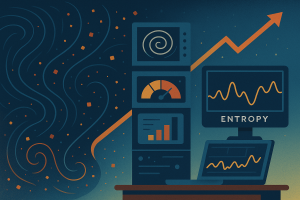When Data Becomes Art: The Quiet Revolution of Synthetic Data in Quantum Computing
There’s something beautifully paradoxical happening at the intersection of synthetic data and quantum computing. We’re creating artificial information to power computers that exist in multiple states simultaneously — as a creative through and through, this act mirrors how I, and other artists, have always imagined possibilities that don’t yet exist in our world.
This convergence feels less like a technological breakthrough and more like a Renaissance moment, where seemingly disparate fields are discovering they speak the same language. HINT: They always have, we just were too arrogant to realize it.
Yes, quantum computers are faster than traditional ones. Yes, they do “magical” things. But nobody truly knows how to make these things hum. We, on the other hand, are imagining industries transform not because they have to, but because they suddenly can.
The magic happens in the spaces between certainty and possibility. Classical computers march through problems step by step, like following a recipe. Quantum systems dance through multiple solutions at once, exploring parallel universes of potential outcomes. When you combine this with synthetic data — information that captures the essence of reality without being real — you get something extraordinary: the ability to train artificial intelligence on scenarios too dangerous, too rare, or too sensitive to encounter in the natural world. Mind… blown.
Use Case One: The Alchemy of Modern Medicine – Synthetic data in pharma
What better place to start than pharma. The gazillion-dollar bucket of human curiosity and the promise to live forever. Aside from our own work, there’s a poetry to what’s happening in pharmaceutical labs these days. Qubit Pharmaceuticals has built something they call ATLAS—perhaps the most aptly named technology we’ve encountered in years. Like its mythological counterpart carrying the weight of the world, this platform carries the weight of our medical futures, unifying physics, AI, and quantum computing in ways that would have seemed like science fiction just a decade ago.
The transformation feels almost alchemical: what once took four months of crystal structure prediction now happens in days, with the computational equivalent of a million laptops working in harmony. It’s not just faster—it’s fundamentally different, like the difference between painting a portrait and dreaming one into existence.
Roche and Cambridge Quantum Computing are exploring Alzheimer’s disease through quantum simulations that model atomic behavior with unprecedented precision. Pfizer has partnered with XtalPi to design drugs using quantum physics principles. These collaborations work because quantum computers don’t just approximate molecular behavior—they mirror it. Molecules exist in quantum superposition states, and now we have computers that can think the same way.
But perhaps the most elegant aspect is how synthetic data solves medicine’s greatest ethical puzzle. How do you study rare diseases without putting patients at risk? How do you share medical insights across borders without compromising privacy? Quantum systems generate their own form of differential privacy. This is not as an add-on feature, but as an intrinsic property. Cleveland Clinic’s dedicated quantum computer exemplifies this approach, enabling global collaboration on synthetic patient datasets while maintaining absolute confidentiality. It’s technology serving humanity in its purest form.
Use Case Two: Reimagining How We Move Through the World
The story of autonomous transportation reads like a meditation on trust and possibility. How do you teach a machine to navigate a world full of variables you’ve never encountered? How do you prepare for the unexpected without experiencing the dangerous?
BMW, Mercedes-Benz, and Volkswagen have become unlikely philosophers in this space, with Volkswagen alone publishing some 15 technical papers exploring quantum applications in ways that blur the line between engineering and art. Airbus partnered with IonQ to solve problems that would make a classical computer melt. Cargo loading optimization and real-time trajectory planning that simultaneously account for air traffic patterns, weather systems, and countless other variables dancing together in computational space.
The 2024 Airbus-BMW Quantum Computing Challenge produced something beautiful: Quandela developed quantum machine learning that transforms limited daytime driving data into realistic nighttime scenarios using boson sampling techniques. It’s synthetic data as creative act… imagining what darkness looks like when you’ve only seen daylight. These are questions we simply never could imagine as finding their answer would have been unthinkable.
Waymo has trained their systems on over 20 billion miles of synthetic simulation data. Let’s re-read that… twenty billion miles. To put that in perspective, that’s enough to circle the Earth 800,000 times. But here’s what makes it remarkable: none of those miles put a single person at risk. Every dangerous scenario, every edge case, every “what if” moment was safely explored in digital space. Even better? Quantum can make short work of these tasks thus amping up the “magic” factor.
The quantum advantage reveals itself most clearly in optimization problems. IonQ’s partnership with Einride focuses on autonomous freight logistics, where quantum algorithms can evaluate exponentially more route combinations than classical computers could process in a lifetime. When UPS saves $300-400 million annually through classical route optimization, you begin to appreciate the potential of quantum systems that can explore not just millions, but billions of route combinations simultaneously. It’s the difference between playing chess one move at a time and seeing the entire game tree unfold before you.
Use Case Three: Beyond the Obvious: Where Quantum Meets the Unexpected
Sometimes the most profound applications emerge in spaces we didn’t think to look. Financial services, for instance, became an unexpected canvas for quantum artistry. IonQ’s collaboration with Fidelity uses quantum generative adversarial networks to simulate market behavior, achieving convergence in 1,000 iterations versus the 20,000 required by classical approaches. But the real breakthrough isn’t speed, it’s the ability to identify hidden patterns in high-dimensional data that classical systems simply cannot perceive. Pattern making is perhaps one of the most unsung heroes of quantum computing. This use case is clearly spot-on match for this but if we imagine outside of finance, we can see how patterns make the magic really happen.
We can ultra-nerd out here too. Multiverse Computing’s work with Bundesdruckerei achieved that magical 15% accuracy improvement over classical GANs while maintaining differential privacy protection. This isn’t just about better numbers; it’s about creating synthetic financial data that preserves the statistical soul of the original without exposing anyone’s personal information. Banks can now share training datasets across borders for fraud detection and credit scoring without regulatory violations; collaboration without compromise.
Materials science reveals quantum computing’s most natural application. ORCA Computing partners with bp to explore hybrid quantum-classical GANs for generating low-energy conformations of hydrocarbon molecules. IonQ’s automotive materials research generates synthetic steel microstructure images that achieve higher quality scores in 70% of cases compared to classical models. These applications succeed because quantum computers don’t just simulate quantum mechanical systems. They are quantum mechanical systems. They speak the same language as the molecules they’re modeling.
Even energy systems are finding quantum solutions. The German Q-GRID project demonstrates how classical optimizers buckle under the exponential complexity of modern power grids, while quantum approaches may solve these challenges as naturally as water flowing downhill. Synthetic data enables testing smart grid configurations and demand response scenarios without risking the lights going out. This is imagination as infrastructure protection.
The Reality of Beautiful Limitations
While the quantum world is ripe with potential, we’d be telling an incomplete story if we painted this as a solved problem. It is not. The truth is more nuanced, more interesting, and ultimately more human. We’re living in what researchers call the Noisy Intermediate-Scale Quantum (NISQ) era. It is a wonderfully honest name that acknowledges we’re still learning to speak quantum.
Current quantum computers operate with gate error rates of 0.1-1%, and quantum states last only microseconds to milliseconds. Beautiful, fleeting moments of computational possibility. IBM and Atom Computing have built machines with over 1,000 qubits, but maintaining coherence and connectivity across such large systems remains an art as much as a science.
The resource requirements for general-purpose quantum advantage remain formidable. We may need millions of qubits to achieve what current systems accomplish with hundreds, and quantum talent, hardware, and supply chains remain precious commodities. Integration complexity creates additional challenges. Classical-quantum interfaces require a new kind of bilingual fluency that we’re still developing.
But there’s beauty in the hybrid approach. Classical-quantum systems that leverage quantum processors for specific computational tasks while using classical computers for data processing represent a pragmatic poetry. Each system doing what it does best, together creating something neither could achieve alone. Research consistently shows this approach can deliver measurable performance improvements even with current hardware limitations. Sometimes the most elegant solutions emerge from embracing constraints rather than fighting them.
We are an active participant in this conversation. We are truly philosophers of this domain and are committed to contributing in a meaningful way to this historical evolution.
The Horizon We’re Moving Toward
There’s something profoundly hopeful about IBM’s roadmap toward 200 logical qubits capable of 100 million quantum gates by 2029, expanding to 2,000 logical qubits with 1 billion gates by 2033. These aren’t just numbers. They represent milestones toward fault-tolerant quantum computing that could deliver sustained advantages over classical systems. They represent futures becoming present.
The investment landscape tells its own story of belief and commitment. China’s $138 billion allocation in government-backed quantum funding signals a long-term vision, while the US National Quantum Initiative’s proposed $2.7 billion over five years demonstrates similar conviction. Private investment remains robust, with quantum computing companies raising $1.25 billion across roughly 50 deals in just Q1 of 2025. Boston Consulting Group projects quantum computing will generate up to $850 billion in annual business value by 2040. The space we are most interested in, according to BCG, is the $90 – $170 billion market for software and associated hardware. While making a quantum computer is difficult, it is nothing compared with the requisite imagination & resources to come up with appropriate use cases. That is where we come in.
The convergence of synthetic data and quantum computing creates immediate opportunities for organizations willing to think differently. Early applications showing quantum advantage in specific optimization problems suggest mainstream quantum adoption within the next decade. The wise move isn’t to wait for perfection—it’s to begin experimenting, building partnerships, and preparing for a quantum-safe future while the landscape is still emerging.
A Reflection on What We’re Building
The intersection of synthetic data and quantum computing represents something deeper than technological advancement—it’s a new form of creative expression where computation becomes art, and artificial information reveals deeper truths about our world. From pharmaceutical companies transforming drug discovery timelines from years to days, to automotive manufacturers optimizing transportation networks of impossible complexity, to financial institutions generating privacy-compliant training datasets that enable global collaboration. We’re witnessing the emergence of tools that amplify human imagination.
What moves us most is how quantum systems naturally protect privacy while processing exponentially complex relationships through synthetic data training. There’s an inherent ethics in the technology itself. There is a built-in respect for human dignity that feels rare in our current technological moment. This isn’t just about faster computers or better algorithms; it’s about creating space for exploration without exploitation, learning without violation, and innovation without compromise.
The organizations investing in quantum synthetic data capabilities now aren’t just positioning themselves for future advantage, they’re participating in the creation of a more thoughtful technological landscape. As fault-tolerant quantum computing systems mature from experimental demonstrations toward practical commercial deployment, we’re not just watching technology evolve; we’re helping to shape how it evolves.
In our own journey, we’ve learned that the most meaningful innovations happen at intersections where different fields discover they speak the same language, where constraints become creative catalysts, and where the impossible gradually becomes inevitable. The convergence of synthetic data and quantum computing feels like one of those moments. We’re thrilled to be around to witness it, and even more excited to see what emerges next.




